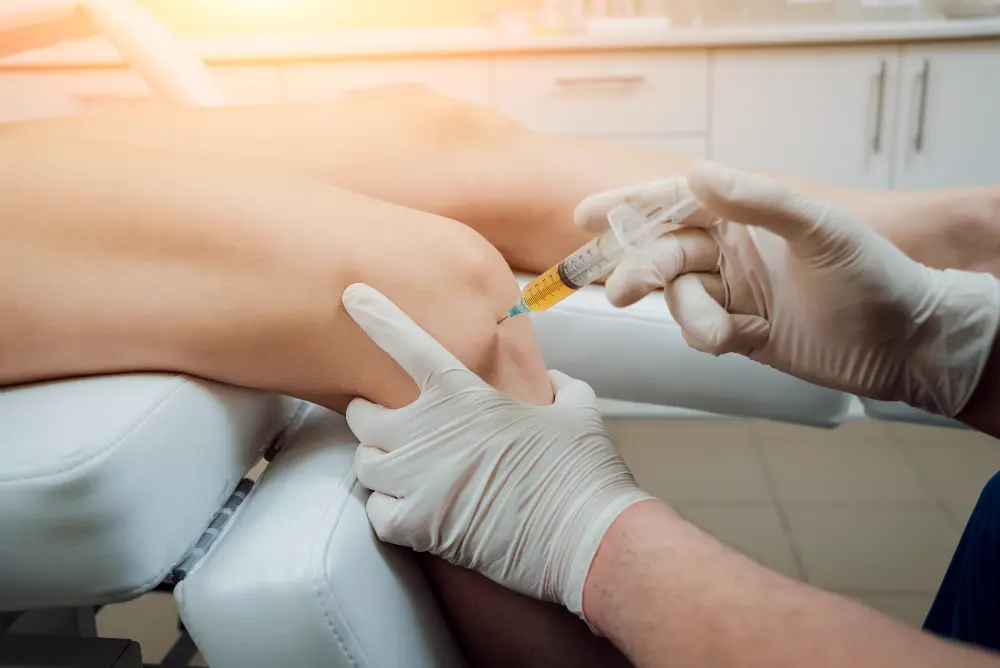If you’re dealing with persistent joint pain, you’ve likely experienced the cycle of Cortisone shots. You get an appointment, the shot provides welcome relief, and for a few weeks, you feel like you have your life back. But then, almost like clockwork, the discomfort returns, sometimes feeling even more frustrating than before. You’re tired of the pain coming back, and you’re wondering if there’s a better way—a solution that does more than just put a temporary bandage on the problem.
For many people searching for an alternative to constant pain medication or invasive procedures like knee replacement surgery, the answer lies in regenerative medicine. At QC Kinetix, we focus on therapies that work in harmony with your body’s own natural healing mechanisms. One such approach is Platelet-Rich Plasma (PRP) therapy, which offers a fundamentally different path compared to traditional Cortisone shots.
This article will dive into the PRP vs. Cortisone debate, exploring their critical differences, explaining how each works, and what the research says about their outcomes. We will explore the science, compare the duration of relief, and help you understand which option may be better aligned with your goal of achieving more sustainable joint health.
Key Takeaways
- PRP therapy uses your body’s own platelets to heal damaged tissue naturally, while Cortisone shots only mask pain temporarily and can weaken joints with repeated use.
- Regenerative medicine addresses the root cause of joint pain by stimulating tissue repair, unlike Cortisone, which provides relief for just 6-12 weeks before wearing off.
- PRP injections promote long-term healing without the risks of steroids, including cartilage breakdown, tendon weakening, and potential joint damage from repeated Cortisone use.
- Studies show PRP therapy can provide pain relief lasting 6-12 months or longer, making it a more sustainable solution than Cortisone shots for chronic joint conditions.
Understanding Your Options: PRP vs. Cortisone for Joint Pain
When you’re exploring non-surgical options for joint discomfort, PRP and Cortisone are two names you’ll frequently encounter. However, they work in entirely different ways.
- Cortisone is a type of corticosteroid, a powerful anti-inflammatory medication that mimics a hormone your body produces naturally. Its primary job is to reduce inflammation quickly, which in turn can lessen pain.
- PRP (Platelet-Rich Plasma) therapy is a form of orthobiologics. It uses a concentration of your own platelets, which are small blood cells packed with natural proteins called growth factors. These growth factors are essential for signaling your body’s inherent healing processes.
Many of our patients come to us after becoming dissatisfied with repeated Cortisone treatments. While initially effective, the relief becomes shorter and less significant over time. This forces the Cortisone vs. PRP choice: continue with a quick, temporary fix that may have diminishing returns, or explore regenerative alternatives to joint surgery designed to work with your body to foster lasting improvement.
How Cortisone Shots Work (And Why They Fall Short)
Cortisone shots deliver a potent dose of anti-inflammatory steroid directly to the painful joint. This can rapidly decrease swelling and calm irritated nerves, providing significant, albeit temporary, relief. For acute flare-ups of pain due to arthritis or other conditions, this can feel like a lifesaver.
The problem is that Cortisone doesn’t address the underlying cause of the discomfort. It simply “masks” the symptoms by shutting down the inflammatory response. It doesn’t do anything to improve or revitalize the damaged cartilage, tendons, or ligaments that are causing the pain in the first place.
Furthermore, repeated use of Cortisone comes with well-documented risks. According to medical literature, frequent steroid treatments in the same joint can weaken surrounding tendons and, most alarmingly, accelerate the breakdown of cartilage. This can contribute to further joint deterioration over time, potentially making the underlying condition worse and pushing you closer to needing major surgery. This is why medical providers typically limit the number of Cortisone shots a person can receive in a single joint per year.
PRP Therapy: Harnessing Your Body’s Natural Healing Power
PRP therapy takes a completely different approach. Instead of introducing a synthetic steroid, we utilize the powerful natural biological tools already present in your own body. The process is straightforward:
- We draw a small sample of your blood, similar to a standard lab test.
- That sample is placed in a centrifuge, a medical device that spins it at high speed.
- This process separates the blood components, allowing us to isolate and concentrate the platelets, creating a solution that is 3 to 5 times richer in platelets than normal blood.
- This platelet-rich plasma is then introduced back into your area of pain.
Once there, the concentrated growth factors get to work, signaling your body’s natural mechanisms to start the process of reviving and enhancing tissue. This approach helps reduce inflammation naturally and gets to the root cause of the pain by supporting the health of the joint itself, rather than just hiding the symptoms.
Learn more about how PRP therapy works.
The Research Is Clear: PRP Outperforms Cortisone
When you compare the two treatments head-to-head, scientific evidence increasingly supports PRP as the superior option for more durable, meaningful improvement in joint function and comfort.
Treatment Duration Comparison
The most significant difference patients notice is how long the relief lasts. Cortisone’s effects are fleeting; research shows pain relief typically lasts about 6 to 12 weeks. In contrast, studies show that because PRP therapy works to improve the underlying tissue, patients can experience improved comfort and function for six months, twelve months, or even longer.
A compelling study on patients with foot pain from plantar fasciitis highlights this difference. At the three-month mark, both groups saw improvement. However, by the 24-month follow-up, the functional scores for the Cortisone group had dropped back nearly to where they started. The PRP group, on the other hand, maintained its significant improvements, demonstrating a much more sustained outcome.
Safety Profile and Risk Factors
When considering any medical treatment, the risk profile is paramount. The primary risk of PRP therapy is minimal, typically involving only mild soreness or irritation at the treatment site for a day or two. Because it uses your own blood, there is little to no risk of an allergic reaction or rejection.
Cortisone, however, carries more significant concerns. As noted by orthopedic sources, repeated steroid use can lead to serious joint deterioration, weaken tendons to the point of potential rupture, and cause cartilage breakdown. PRP avoids these risks by using natural, biologic factors that support tissue health rather than degrade it.
Functional Improvement Scores
Beyond just pain levels, it’s crucial to look at functional improvement—how well can you move and live your life? A 2024 systematic review and meta-analysis of 599 patients directly compared PRP and Cortisone. It found that PRP was significantly superior for functional improvement, showing an average advantage of 16.13 points on the AOFAS score, a standard measure for foot and ankle function.
What do numbers like that mean for you? It’s the difference between struggling to walk up a flight of stairs and doing so with ease. It’s the ability to return to the golf course, play with your grandchildren, or simply enjoy a walk without constant, nagging pain.
Making the Right Choice for Your Joint Health
Deciding on a treatment path is a personal journey. It depends on your condition, your health goals, and your desire for a short-term fix versus a long-term solution.
Is PRP Right for You?
✓ You’re a Good Candidate for PRP if You:
- Have chronic joint pain from arthritis, injury, or degeneration that’s limiting your daily activities or quality of life
- Tried Cortisone shots that provided only temporary relief or stopped working after multiple injections
- Want to avoid surgery and its associated risks, pain, and lengthy recovery time
- Prefer natural healing using your body’s own biologics rather than steroids or pharmaceutical drugs
- Are an active person or athlete looking to return to sports, exercise, or recreational activities
- Have been told by doctors there’s “nothing more they can do” besides limiting activities or surgery
- Are willing to invest in gradual, lasting improvement over weeks to months rather than seeking instant relief
✗ PRP May NOT Be Right for You if You:
- Have an active infection, cancer, severe anemia, or blood clotting disorders
- Are looking for immediate pain relief (Cortisone works faster initially)
- Cannot commit to multiple treatment sessions if recommended by your provider
- Have unrealistic expectations about completely reversing severe, end-stage joint damage
If you see yourself in the “Good Candidate” list, the next step is a personalized assessment. Schedule your free consultation today to discuss your specific situation with our medical team.
What to Expect: Your PRP Journey at QC Kinetix
Your journey with us begins with a no-obligation consultation. Our medical team will sit down with you, review your history, and determine if you are a good candidate for our regenerative therapies. We believe in creating personalized treatment plans because every patient and every condition is unique.
Should you move forward, your treatment protocol will be customized for you. Improvement with PRP therapy is gradual. It happens over weeks and months as your body’s natural mechanisms are stimulated. A key benefit of our non-surgical therapies is that there is little to no downtime. You can return to your daily activities right away, without the lengthy and difficult recovery associated with surgery.
FAQs about PRP vs. Cortisone
Q: What’s the main difference between PRP injections and Cortisone shots for joint pain?
A: PRP uses your own blood platelets to naturally stimulate tissue healing and regeneration, while Cortisone is a steroid that only reduces inflammation temporarily without repairing the actual damage.
Q: How long do results typically last from PRP therapy compared to Cortisone shots?
A: PRP therapy can provide pain relief that lasts many months by promoting actual tissue repair, while Cortisone shots typically wear off in 6-12 weeks and require repeated injections.
Q: What are the risks of repeated Cortisone shots that PRP therapy avoids?
A: Multiple Cortisone injections can weaken tendons, contribute to cartilage breakdown, and potentially damage joint tissue, while PRP uses your body’s natural healing factors without these degenerative risks.
Q: Why is PRP a better long-term solution than Cortisone shots?
A: PRP addresses the root cause of joint pain by stimulating your body’s natural healing processes to restore healthy tissue, while Cortisone only masks symptoms temporarily without healing the underlying problem.
Q: Who benefits most from choosing PRP therapy over Cortisone injections?
A: People with chronic joint pain, sports injuries, or arthritis who want lasting relief without surgery or the risks associated with repeated steroid injections benefit most from PRP’s regenerative approach.
Q. Where can I find PRP therapy near me?
QC Kinetix offers PRP therapy in dozens of cities across the country. Visit our locations page to find our regenerative medicine clinic closest to you.
Take the First Step Toward Lasting Relief
Don’t let joint pain dictate what you can and can’t do. If you’re ready to move beyond the temporary cycle of Cortisone shots and explore an approach that works with your body, QC Kinetix is here to help. Our regenerative therapies offer a different path—one focused on improving your body’s own ability to revitalize tissue for more sustainable joint health.
Stop searching for “alternatives to hip replacement” or “non-surgical knee pain relief” and start your journey toward a more active and comfortable life.Schedule your free consultation at a QC Kinetix location near you and discover if PRP therapy is the right choice for you.
Ready to start your healing journey? Schedule your free consultation today to discuss personalized treatment options.


